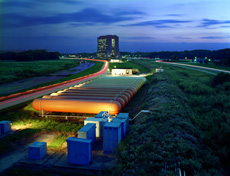Closing in on the Higgs

The Tevatron experiments will reach into the region considered the most-likely to house the low-mass Higgs boson.
CDF and DZero collaborators last week described the path to the Higgs boson they hope to continue forging through 2010.
CDF and DZer co-spokesmen Rob Roser and Darien Wood, spoke to the Particle Physics Project Prioritization Panel, the group charged with recommending a 10-year plan for U.S. HEP.
"2007 was a really good year for us, and we expect 2008 to be better," Wood said, citing a banner year of 34 scientific papers submitted in 2007 by DZero. "And the physics prospects for 2010 are exciting."
Both experiment teams told P5 that their collaborators would have smooth-running detectors and ample personnel through 2010.
The Tevatron could reap more discoveries before its scheduled shut down in 2009, but with an additional year of operation, the CDF and DZero experiments would have more than twice the data available today. That opens the door to compelling physics such as the first exploration of the Terascale, a better definition of top-quark mass and finding the Higgs boson.
"We think taking advantage of the Tevatron's discovery potential is the right way to end the experiment," Roser said.
Physicists expect the Higgs to give off a very small signal amidst very large background, making it tricky prey to corner. Yet, other measurement constraints, including some from the Tevatron experiments, have narrowed in on the region considered the most likely home of a light-mass Higgs, the 115 to 182 GeV mass region.
By the end of 2009, researchers will have a good indication of the Higgs' possible existence in the LHC's so-called sweet-spot mass range of 155 to 170 GeV. Another year of data could extract the first evidence for a Higgs in that mass range.
"The Higgs production and decay modes we look for at low mass at Fermilab are not the same as CERN scientists look for with the LHC," Wood said. "There is a complementary nature. There is a productive period of overlap expected."
-- Tona Kunz
|